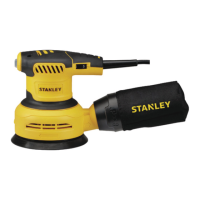7
ENGLISH
WARNING: Do not sand magnesium!
NOTICE: If you wrap the cord around the tool when you
store it, leave a generous loop of cord such that the cord
guard does not bend.
This helps prevent premature cord failure.
Proper Hand Position (Fig. D)
WARNING: To reduce the risk of serious
personal injury, ALWAYS use proper hand
position as shown.
WARNING: To reduce the risk of serious
personal injury, ALWAYS hold securely in
anticipation of a sudden reaction.
Proper hand position requires either one hand
on the sander body (10) or one hand on the main
grip (11) as shown.
Switching On and Off (Fig. A)
Set the sanding speed using the electronic speed control
dial (2).
To switch the tool on, set the on/off switch to position I.
To switch the tool off, set the on/off switch to position O.
Sanding
Start with the coarsest grit size.
As the tool produces small abrasion marks in all directions,
it is not necessary to sand along the grain.
Check your work at short intervals.
Always switch off the tool when work is finished and before
unplugging.
Hints for optimum use
♦ Do not exert too much pressure on the tool.
♦ Regularly check the condition of the sanding paper.
♦ Replace sanding paper when necessary.
♦ When sanding new layers of paint before applying
another layer, use extra fine grit.
♦ On very uneven surfaces, or when removing layers of
paint, start with a coarse grit. On other surfaces, start
with a medium grit. In both cases, gradually change to
a fine grit for a smooth finish.
♦ Consult your retailer for more information on available
accessories.
Residual risks
Additional residual risks may arise when using the tool
which may not be included in the enclosed safety warnings.
These risks can arise from misuse, prolonged use etc.
Even with the application of the relevant safety regulations
and the implementation of safety devices, certain residual
risks can not be avoided. These include:
♦ Injuries caused by touching any rotating/moving parts.
♦ Injuries caused when changing any parts, blades or
accessories.
♦ Injuries caused by prolonged use of a tool. When using
any tool for prolonged periods ensure you take regular
breaks.
♦ Impairment of hearing.
♦ Health hazards caused by breathing dust developed
when using your tool (example:- working with wood,
especially oak, beech and MDF.)
MAINTENANCE
Your STANLEY power tool has been designed to operate
over a long period of time with a minimum of maintenance.
Continuous satisfactory operation depends upon proper
tool care and regular cleaning.
♦ Regularly clean the ventilation slots in your tool using
a soft brush or dry cloth.
♦ Regularly clean the motor housing using a damp cloth.
Do not use any abrasive or solvent-based cleaner.This
machine is not user-serviceable. If problems occur
contact an authorised repair agent.
Lubrication
Your power tool requires no additional lubrication.
Cleaning
WARNING: Blow dirt and dust out of the main
housing with dry air as often as dirt is seen
collecting in and around the air vents. Wear
approved eye protection and approved dust
mask when performing this procedure.
WARNING: Never use solvents or other harsh
chemicals for cleaning the non-metallic parts of
the tool. These chemicals may weaken the
materials used in these parts. Use a cloth
dampened only with water and mild soap. Never
let any liquid get inside the tool; never immerse any part of
the tool into a liquid.
To maintain products SAFETY and RELIABILITY,
repair, carbon brush inspection and replacement, any
other maintenance or adjustment should be performed
by STANLEY Service Centers, always using Stanley
replacement parts.
Optional Accessories
WARNING: Since accessories, other than those
offered by STANLEY, have not been tested with
this product, use of such accessories with this
tool could be hazardous. To reduce the risk of injury, only
STANLEY, recommended accessories should be used
with this product.
Consult your dealer for further information on the
appropriate accessories.
Protecting The Environment
Separate collection. This product must not be
disposed of with normal household waste.
Should you find one day that your STANLEY product
needs replacement, or if it is of no further use to you, do
not dispose of it with household waste. Please sort it out
for separate recycling.

